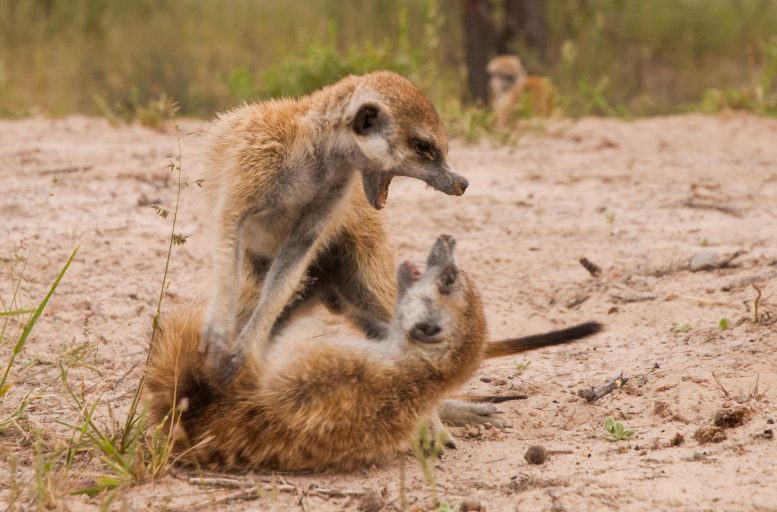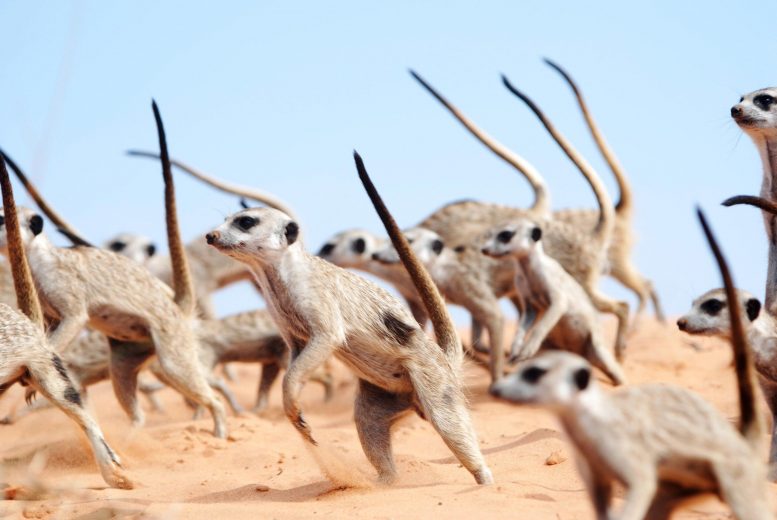Meerkat clans perform a ‘war dance’ to frighten opponents and protect their territory, according to a new UCL and University of Cambridge study.
Published in Proceedings of the Royal Society B, this is the first empirical study to reveal intergroup aggression.
The researchers, who monitored hundreds of these intergroup encounters over 11 years, show that meetings between meerkat clans often turn aggressive and sometimes escalate to fighting and lethal violence.
The study reveals that in more than half of interactions (64.7%) meerkat clans’ exhibit aggression by either chasing or doing a ‘war dance’, where a meerkat displays an erect tail and puffed-out fur, possibly to make the group appear larger than its size.
Lead author and evolutionary anthropologist Dr. Mark Dyble (UCL Anthropology and formerly of University of Cambridge), said: “We show that interactions between meerkat groups are never tolerant, that the majority involve some form of aggression and that a minority result in physical violence.
“However, even when interactions between meerkat groups do not result in physical violence, they may have territorial consequences, with losing groups moving to sleeping burrows closer to the center of their territory and winning groups moving to burrows further from the center of their territory.”
Meerkats live in stable and highly social groups and within these clans there are high levels of cooperation. Each clan is made up of about 20 members and there is a dominant male and a dominant female who monopolize reproduction, producing more than 80% of offspring born in the group.
Like many carnivores, meerkats are territorial and deposit feces and scent marks at sites both within their territories and at important locations on territorial boundaries. Clans work together to defend territories and regularly have aggressive interactions with neighbors.
The researchers observed six different behaviors when intergroup meeting occurs: initial observation of the rival group, chasing the rival group, performing a war dance, retreating from interaction, excavating the rival groups’ burrow and engaging in aggressive physical contact. The whole interaction, which typically lasts around 20 minutes, usually consists of a sequence of these six behaviors.
In the vast majority of cases (86%), aggressions ended with one of the two groups retreating before direct physical contact. However, in a few cases (9%) those interactions resulted in fighting with at least one meerkat killed.
These interactions have consequences for group territories, with losing groups moving to sleeping burrows closer to the center of their territories and winning groups moving further away.
Overall, the researchers found that nearly half (48%) of all aggression between groups was initiated by the dominant male, 15% by the dominant female, 14.5% by a subordinate male and 12% by a subordinate female. In addition, meerkat clans with more members and pups were more likely to win.
For the study, data was collected between January 2008 and February 2019 as part of a long-term behavioral study of wild meerkats in the Kalahari Meerkat Project, South Africa. The Kalahari desert is a semi-arid environment where rainfall and temperature vary dramatically.
The study population normally includes 10 groups of an average size of approximately 20 individuals and the final data set comprised 422 interactions involving 78 combinations of 36 different meerkat groups.
Dr. Dyble concluded: “If we want to fully understand violence in human societies, we need to understand its evolutionary roots. This requires us to understand why other animal groups fight, and what do they gain or lose from doing so. We show that although meerkat intergroup aggression only occasionally results in an individual being killed, winning fights with neighboring groups is critical to maintaining a territory. In the harsh semi-desert of the Kalahari, a good quality territory is critical to a group’s survival and long-term success.”
Reference: “Intergroup aggression in meerkats” by Mark Dyble, Thomas M. Houslay, Marta B. Manser and Tim Clutton-Brock, 18 December 2019, Proceedings of the Royal Society B.
DOI: 10.1098/rspb.2019.1993
The research was carried out with the Kalahari Research Center and was funded by the European Research Council, the MAVA Foundation, the University of Zurich, and the Mammal Research Institute at the University of Pretoria.











Be the first to comment on "Meerkat Mobs Do Frightening ‘War Dance’ to Protect Territory [Video]"